Effect of Strengthening Methods on Two-Way Slab under Low-Velocity Impact Loading
Abstract
:1. Introduction
2. Materials and Methods
2.1. Mix Proportions and Materials
2.2. Details of Test Specimens
2.3. Strengthening Methods
2.4. Test Setup for Drop-Weight Test
3. Results and Discussion
3.1. Drop-Weight Test
3.1.1. Load-Time Curves
3.1.2. Deflection-Time Curves
3.1.3. Energy Dissipation Capacity
3.2. Effect of Carbon Fiber and NSHSDC on Damage Assessment
3.2.1. Damage Assessment Based on Support Rotation
3.2.2. Cracks and Damage
3.2.3. Weight Loss
3.3. Comparison of Previous and Experimental Test
4. Conclusions
- (1)
- The NSC-NF showed excellent impact resistance and high strength. In particular, the highest strength and lowest deflection were obtained when strengthening the top and bottom sides with NSHSDC; the cracks were confirmed to spread evenly under the test specimens. This is because steel fibers and PE fibers included in the NSHSDC effectively control macro-cracking and micro-cracking and spread impact energy evenly throughout the test specimen.
- (2)
- Comparing deflection at the first blow, the lowest maximum deflection was observed in the NC-F specimen, which was 26% lower than that of the control specimen. This is attributed to the fact that CFS increased the initial stiffness. Overall, at the first blow, the carbon fiber series showed less deflection than the NSHSDC series; however, at the final blow, the ratio of maximum deflection to residual deflection decreased.
- (3)
- The crack of NSC-NF not only spread the crack evenly at the bottom but also improved the deflection capacity according to using NSHSDC, which was a hybrid using PE and steel fibers. However, strengthening with FRP and sprayed FRP cannot confirm the cracks due to the FRP adhesion. The NC-F was delaminated with the FRP, which showed the largest damaged area and exposed the tensile reinforcement. The sprayed FRP may have caused brittle fracture due to the stress concentration at the tensile section.
- (4)
- The NSC-NF showed a weight loss ratio of about 1 kg on the final blow, which is only about 0.12% of the total weight. However, the weight loss rate of the test specimen strengthened with FRP on the bottom side is approximately 2–3% of the total weight. This is due to the high ductility of the specimen as a bridging effect of steel fiber and PE fiber. Thus, the measured weight loss of the NSC-NF was smaller than that of the FRP series.
- (5)
- Compared with the previous studies, NSC-NF showed best impact resistance in the test specimens applying the strengthening techniques, but it showed disadvantage in load and deflection SFRC concrete and UHPC. However, it can be expected to further research studies on the applicability of the NSHSDC in that it can be manufactured with the thin layer while strengthening the existing concrete.
Author Contributions
Funding
Conflicts of Interest
References
- Thabet, A.; Haldane, D. Three-dimensional simulation of nonlinear response of reinforced concrete members subjected to impact loading. Struct. J. 2000, 97, 689–702. [Google Scholar]
- Fujikake, K.; Li, B.; Soeun, S. Impact response of reinforced concrete beam and its analytical evaluation. J. Struct. Eng. 2009, 97, 938–950. [Google Scholar] [CrossRef]
- Tomas, R.J.; Sorensen, A.D. Review of Strain Rate Effects for UHPC in Tension. Constr. Build. Mater. 2017, 153, 846–856. [Google Scholar] [CrossRef]
- Hrynyk, T.D.; Vecchio, F.J. Behavior of Steel Fiber-Reinforced Concrete Slabs under Impact Load. ACI Struct. J. 2014, 111, 1213–1224. [Google Scholar] [CrossRef] [Green Version]
- Foret, G.; Limam, O. Experimental and numerical analysis of RC two-way slabs strengthened with NSM CFRP rods. Constr. Build. Mater. 2008, 20, 2025–2030. [Google Scholar] [CrossRef]
- Bhatti, A.Q.; Kishi, N.; Tan, K.H. Impact resistant behaviour of RC slab strengthened with FRP sheet. Mater. Struct. 2011, 44, 1855–1864. [Google Scholar] [CrossRef]
- Yoo, D.Y.; Yoon, Y.S. Influence of steel fibers and fiber-reinforced polymers on the impact resistance of one-way concrete slabs. J. Compos. Mater. 2014, 48, 695–706. [Google Scholar] [CrossRef]
- Radnic, J.; Matesan, D.; Grgic, N.; Baloevic, G. Impact testing of RC slabs strengthened with CFRP strips. Compos. Struct. 2015, 121, 90–103. [Google Scholar] [CrossRef]
- Wang, W.; Chouw, N. Experimental and theoretical studies of flax FRP strengthened coconut fibre reinforced concrete slabs under impact loadings. Constr. Build. Mater. 2018, 171, 546–557. [Google Scholar] [CrossRef]
- Yilmaz, T.; Kirac, N.; Anil, O.; Erdem, R.T.; Sezer, C. Low-velocity impact behaviour of two way RC slab strengthening with CFRP strips. Constr. Build. Mater. 2018, 186, 1046–1063. [Google Scholar] [CrossRef]
- Elnagar, A.B.; Afefy, H.M.; Baraghith, A.T.; Mahmoud, M.H. Experimental and numerical investigations on the impact resistance of SHCC-strengthened RC slabs subjected to drop weight loading. Constr. Build. Mater. 2019, 229. [Google Scholar] [CrossRef]
- Yang, J.Q.; Smith, S.T.; Wang, Z.; Lim, Y.Y. Numerical simulation of FRP-strengthened RC slabs anchored with FRP anchors. Constr. Build. Mater. 2018, 172, 735–750. [Google Scholar] [CrossRef]
- Soltani, H.; Khaloo, A.; Sadraie, H. Dynamic performance enhancement of RC slabs by steel fibers vs. externally bonded GFRP sheets under impact loading. Eng. Struct. 2020, 213, 110539. [Google Scholar] [CrossRef]
- Loganaganandan, M.; Murali, G.; Salaimanimagudam, M.P.; Haridharan, M.K.; Karthikeyan, K. Experimental Study on GFRP Strips Strengthened New Two Stage Concrete Slabs under Falling Mass Collisions. KSCE J. Civil Eng. 2020, 1–10. [Google Scholar] [CrossRef]
- Mahmoud, M.H.; Afefy, H.M.; Baraghith, A.T.; Elnagar, A.B. Impact and static behavior of strain-hardening cementitious composites-strengthened reinforced concrete slabs. Adv. Struct. Eng. 2020, 23, 1614–1628. [Google Scholar] [CrossRef]
- Chen, J.F.; Yuan, H.; Teng, J.G. Debonding failure along a softening FRP-to-concrete interface between two adjacent cracks in concrete members. Eng. Struct. 2007, 29, 259–270. [Google Scholar] [CrossRef]
- Dong, J.F.; Wang, Q.Y.; Guan, Z.W. Structural behaviour of RC beams externally strengthened with FRP sheets under fatigue and monotonic loading. Eng. Struct. 2012, 29, 259–270. [Google Scholar] [CrossRef]
- Daud, R.A.; Cunningham, L.S.; Wang, Y.C. Static and fatigue behaviour of the bond interface between concrete and externally bonded CFRP in single shear. Eng. Struct. 2015, 97, 54–67. [Google Scholar] [CrossRef]
- Mohammed, T.J.; Bakar, B.A.; Bunnori, N.M. Torsional improvement of reinforced concrete beams using ultra high-performance fiber reinforced concrete (UHPFC) jackets—Experimental study. Constr. Build. Mater. 2016, 106, 533–542. [Google Scholar] [CrossRef]
- Attari, N.; Amziane, S.; Chemrouk, M. Flexural strengthening of concrete beams using CFRP, GFRP and hybrid FRP sheets. Constr. Build. Mater. 2012, 37, 746–757. [Google Scholar] [CrossRef]
- Banthia, N.; Boyd, A.J. Sprayed fibre-reinforced polymers for repairs. Can. J. Civ. Eng. 2000, 27, 907–915. [Google Scholar] [CrossRef]
- Parghi, A.; Alam, M.S. A review on the application of sprayed-FRP composites for strengthening of concrete and masonry structures in the construction sector. Compos. Struct. 2018, 187, 518–534. [Google Scholar] [CrossRef]
- Han, S.C.; Yang, J.M.; Yoon, Y.S. Evaluation on strengthening capacities and rebound rate of structures with sprayed FRP. J. Korea Inst. Struct. Maint. Insp. 2008, 12, 193–202. [Google Scholar]
- Chang, J.H.; Jang, K.S. Performance evaluation of structure strengthening using sprayed FRP technique. J. Korea Inst. Struct. Maint. Insp. 2009, 13, 126–136. [Google Scholar]
- Aoude, H.; Belghiti, M.; Cook, W.D.; Mitchell, D. Response of steel fiber-reinforced concrete beams with and without Stirrups. ACI Struct. J. 2012, 109, 359–367. [Google Scholar]
- Ong, K.C.G.; Basheerkhan, M.; Paramasivam, P. Resistance of fibre concrete slabs to low velocity projectile impact. Cem. Concr. Compos. 1999, 21, 391–401. [Google Scholar] [CrossRef]
- Hable, K.; Paul, G. Response of ultra-high performance fiber reinforced concrete (UHPFRC) to impact and static loading. Cem. Concr. Compos. 2008, 30, 938–946. [Google Scholar] [CrossRef]
- Yang, I.H.; Joh, C.B.; Kim, B.S. Structural behavior of ultra high performance concrete beams subjected to bending. Eng. Struct. 2010, 32, 3478–3487. [Google Scholar] [CrossRef]
- Yoo, D.Y.; Banthia, N.; Yoon, Y.S. Impact resistance of reinforced ultra-high-performance concrete beams with different steel fibers. ACI Struct. J. 2017, 114. [Google Scholar] [CrossRef]
- Yoo, D.Y.; Banthia, N.; Kim, S.W.; Yoon, Y.S. Response of ultra-high-performance fiber-reinforced concrete beams with continuous steel reinforcement subjected to low-velocity impact loading. Compos. Struct. 2015, 126, 233–245. [Google Scholar] [CrossRef]
- Yoo, D.Y.; Yoon, Y.S. Structural Performance of Ultra-High-Performance Concrete Beams with Different Steel Fibers. Eng. Struct. 2015, 102, 409–423. [Google Scholar] [CrossRef]
- Kim, D.J.; Park, S.H.; Ryu, G.S.; Koh, K.T. Comparative flexural behavior of hybrid ultra high performance fiber reinforced concrete with different macro fibers. Constr. Build. Mater. 2011, 25, 4144–4155. [Google Scholar] [CrossRef]
- Zanuy, C.; Ulzurrun, G.S.D. Impact resisting mechanisms of shear-critical reinforced concrete beams strengthened with high-performance FRC. Appl. Sci. 2020, 10, 3154. [Google Scholar] [CrossRef]
- Lampropoulos, A.P.; Paschalis, S.A.; Tsioulou, O.T.; Dritsos, S.E. Strengthening of reinforced concrete beams using ultra high performance fiber reinforced concrete (UHPFRC). Eng. Struct. 2016, 106, 370–384. [Google Scholar] [CrossRef] [Green Version]
- Yuan, T.F.; Lee, J.Y.; Min, K.H.; Yoon, Y.S. Experimental investigation on mechanical properties of hybrid steel and polyethylene fiber reinforced no-slump high strength concrete. Int. J. Polym. Sci. 2019, 2019, 1–11. [Google Scholar] [CrossRef] [Green Version]
- Yuan, T.F.; Lee, J.Y.; Min, K.H.; Yoon, Y.S. Bond strength and flexural capacity of normal concrete beams strengthened with no-slump high-strength, high-ductility concrete. Materials 2020, 13, 4218. [Google Scholar] [CrossRef]
- Lee, N.H.; Kim, J.H.J.; Han, T.S.; Cho, Y.G.; Lee, J.H. Blast-resistant characteristics of ultra-high strength concrete and reactive powder concrete. Constr. Build. Mater. 2012, 28, 694–707. [Google Scholar] [CrossRef]
- American Society for Testing and Materials (ASTM). ASTM C39/C39M Standard test method for compressive strength of cylindrical concrete specimens. In Annual Book of ASTM Standards; ASTM: West Conshohocken, PA, USA, 2014. [Google Scholar]
- American Society for Testing and Materials (ASTM). ASTM C1609/C1609 M. Standard test method for flexural performance of fiber-reinforced concrete (using beam with third-point loading). In Annual Book of ASTM Standards; ASTM: West Conshohocken, PA, USA, 2012. [Google Scholar]
- Lee, J.Y.; Yuan, T.Y.; Shin, H.O.; Yoon, Y.S. Strategic use of steel fibers and stirrups on enhancing impact resistance of ultra-high-performance fiber-reinforced concrete beams. Cem. Concr. Compos. 2020, 107. [Google Scholar] [CrossRef]
- Isaac, P.; Darby, A.; Ibell, T.; Evernden, M. Experimental investigation into the force propagation velocity due to hard impacts on reinforced concrete members. Int. J. Impact. Eng. 2017, 100, 131–138. [Google Scholar] [CrossRef]
- Pham, T.M.; Hao, H. Plastic hinges and inertia forces in RC beams under impact loads. Int. J. Impact. Eng. 2017, 103, 1–11. [Google Scholar] [CrossRef] [Green Version]
- Huo, J.; Li, Z.; Zhao, L.; Liu, J.; Xiao, Y. Dynamic behavior of carbon fiber-reinforced polymer- strengthened reinforced concrete beams without stirrups under impact loading. ACI Struct. J. 2018, 115, 775–787. [Google Scholar] [CrossRef]
- Saatci, S.; Vecchio, F.J. Effects of shear mechanisms on impact behavior of reinforced concrete beams. ACI Struct. J. 2009, 106, 78–86. [Google Scholar]
- Nghiem, A.; Kang, T.H.-K. Drop-weight testing on concrete beams and ACI design equations for maximum and residual deflections under low-velocity impact. ACI Struct. J. 2020, 117, 199–210. [Google Scholar] [CrossRef]
- Cao, Y.Y.Y.; Liu, G.; Brouwers, H.J.H.; Yu, Q. Enhancing the low-velocity impact resistance of ultra-high-performance concrete by an optimized layered-structure concept. Compos. B Eng. 2020, 200. [Google Scholar] [CrossRef]
- United States Department of Defense. UFC 3-340-02, Structures to Resist the Effects of Accidental Explosions; United States Department of Defense: Washington, DC, USA, 2008.
- Lee, J.Y.; Shin, H.O.; Min, K.H.; Yoon, Y.S. Flexural assessment of blast-damaged RC beams retrofitted with CFRP sheet and steel fiber. Int. J. Polym. Sci. 2018, 2018. [Google Scholar] [CrossRef]
- Jang, D.S. Damage Assessment of Two-Way RC Slabs Subjected to Low-Velocity Impact Loading. Master’s Thesis, University of Korea, Seoul, Korea, 5 January 2015. [Google Scholar]
- Kim, D.H. Impact Resistance of SFRC Slabs upon Steel Fiber Content and Concrete Strength. Master’s Thesis, University of Korea, Seoul, Korea, 7 January 2017. [Google Scholar]

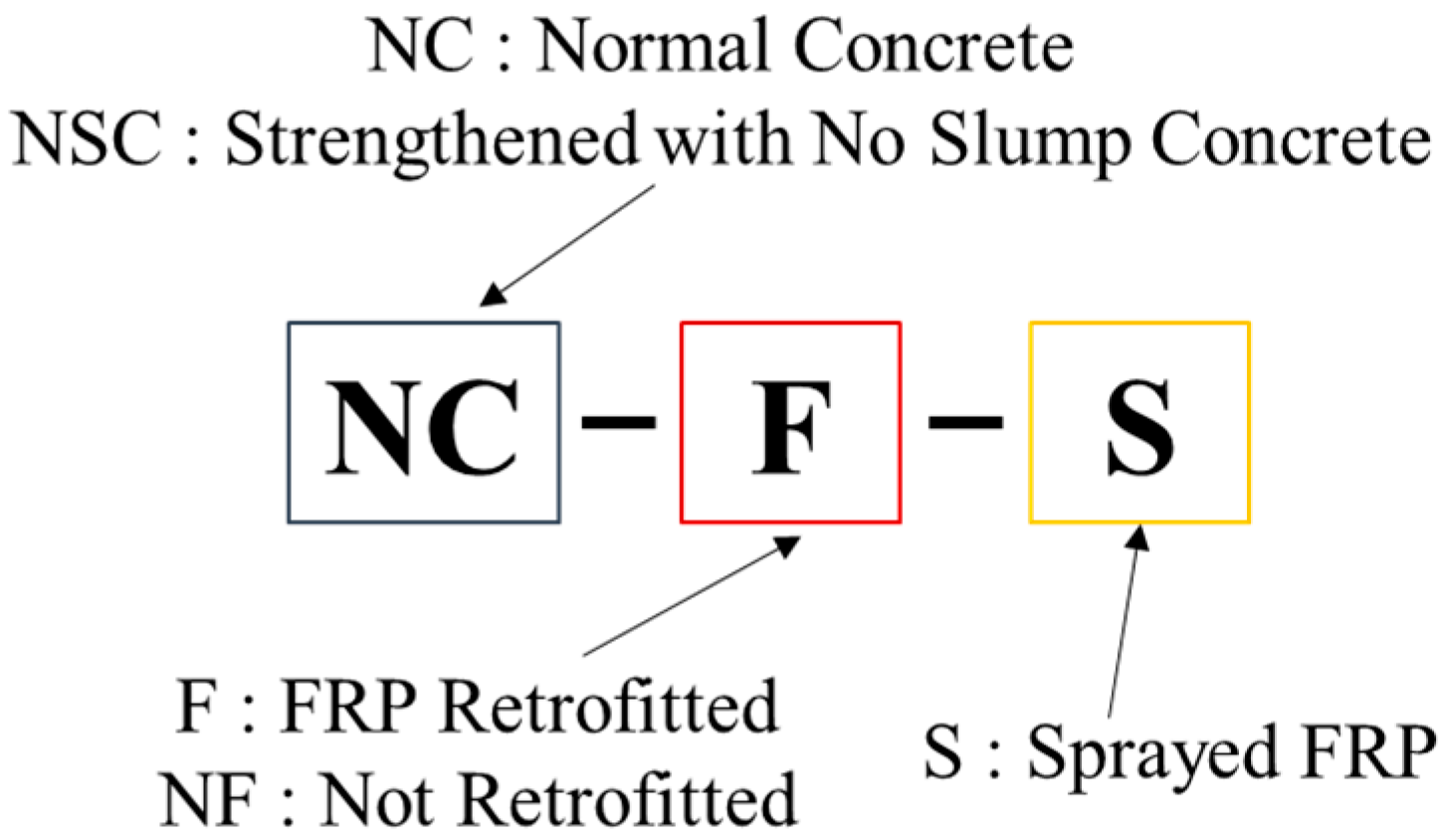
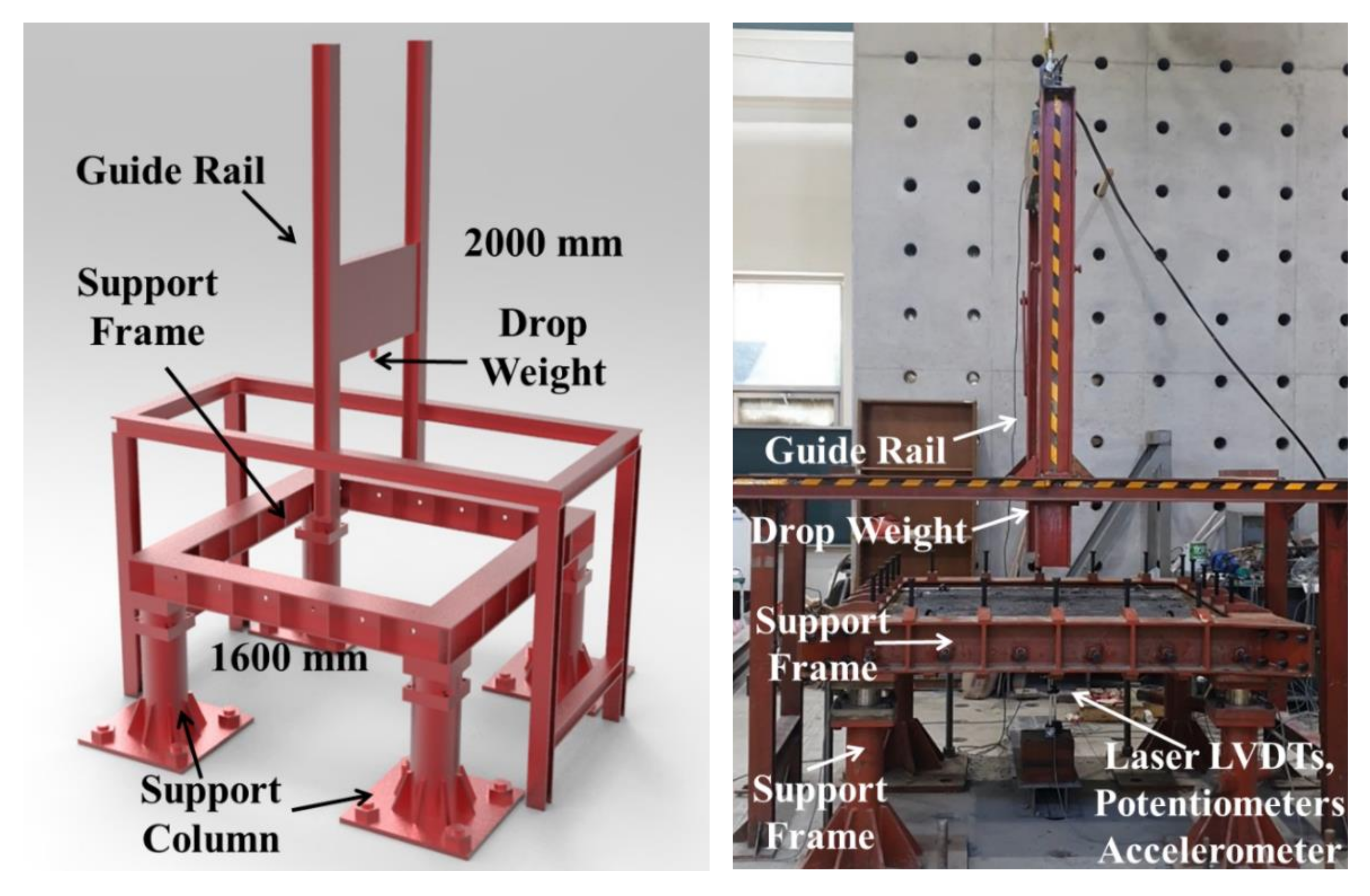
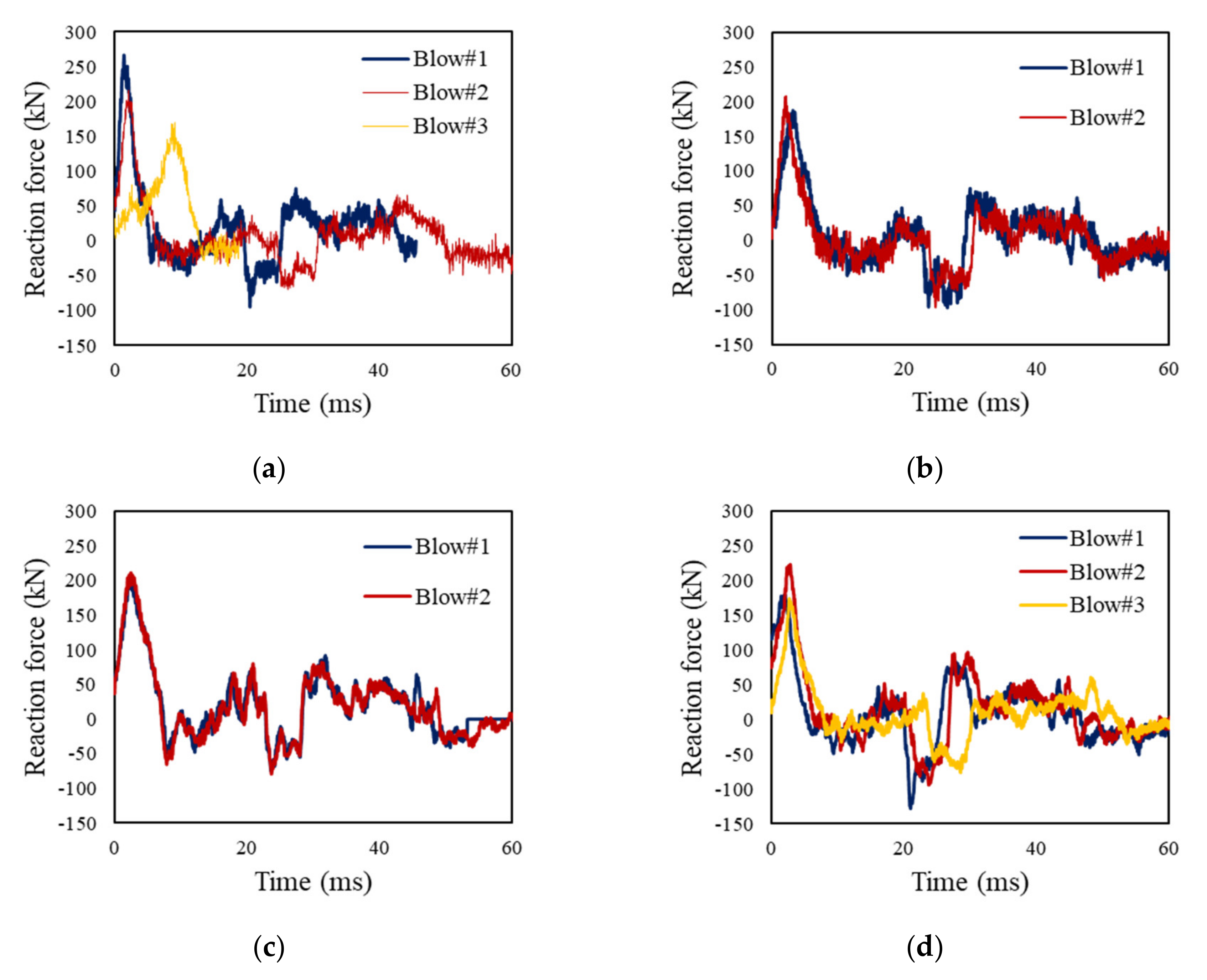
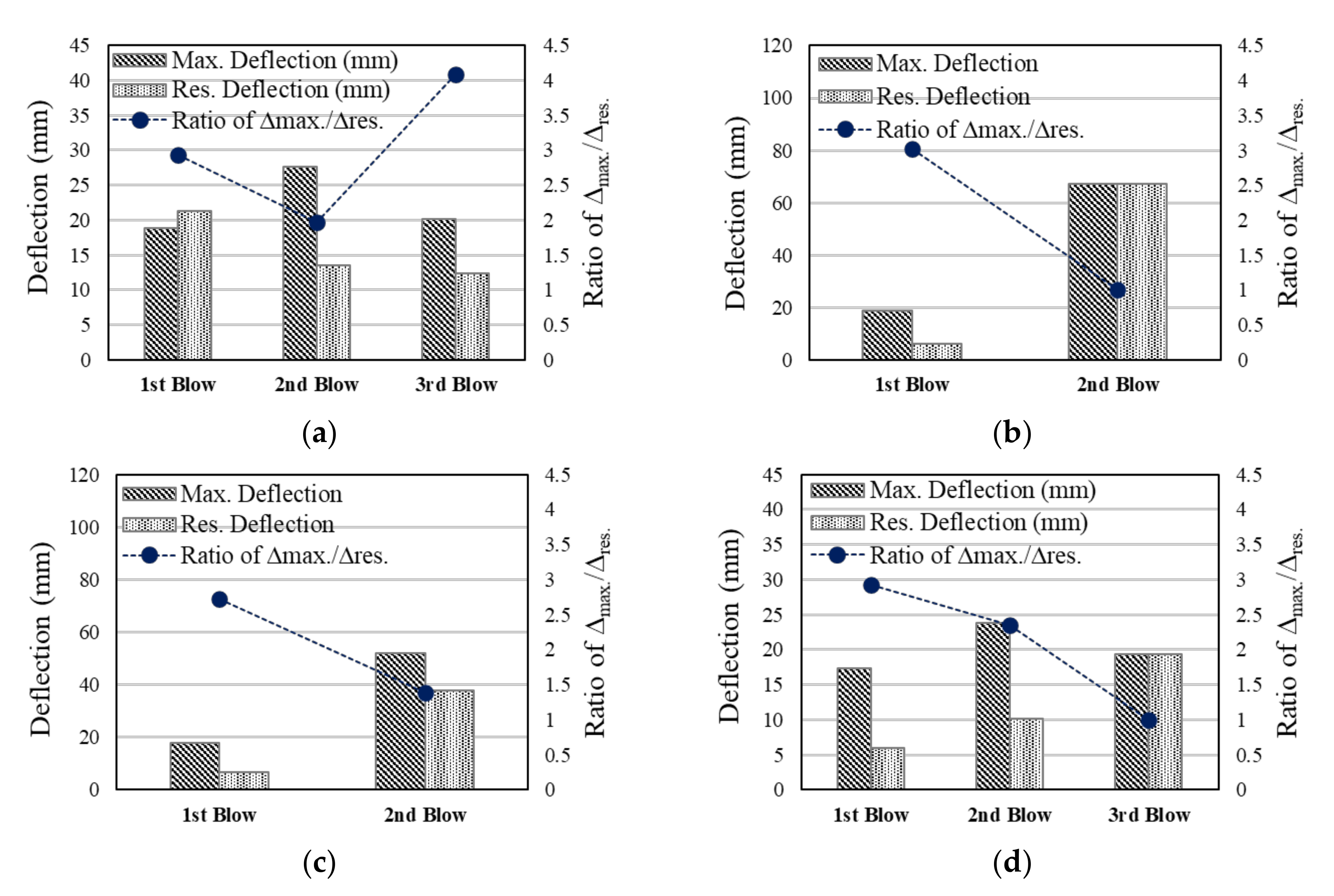
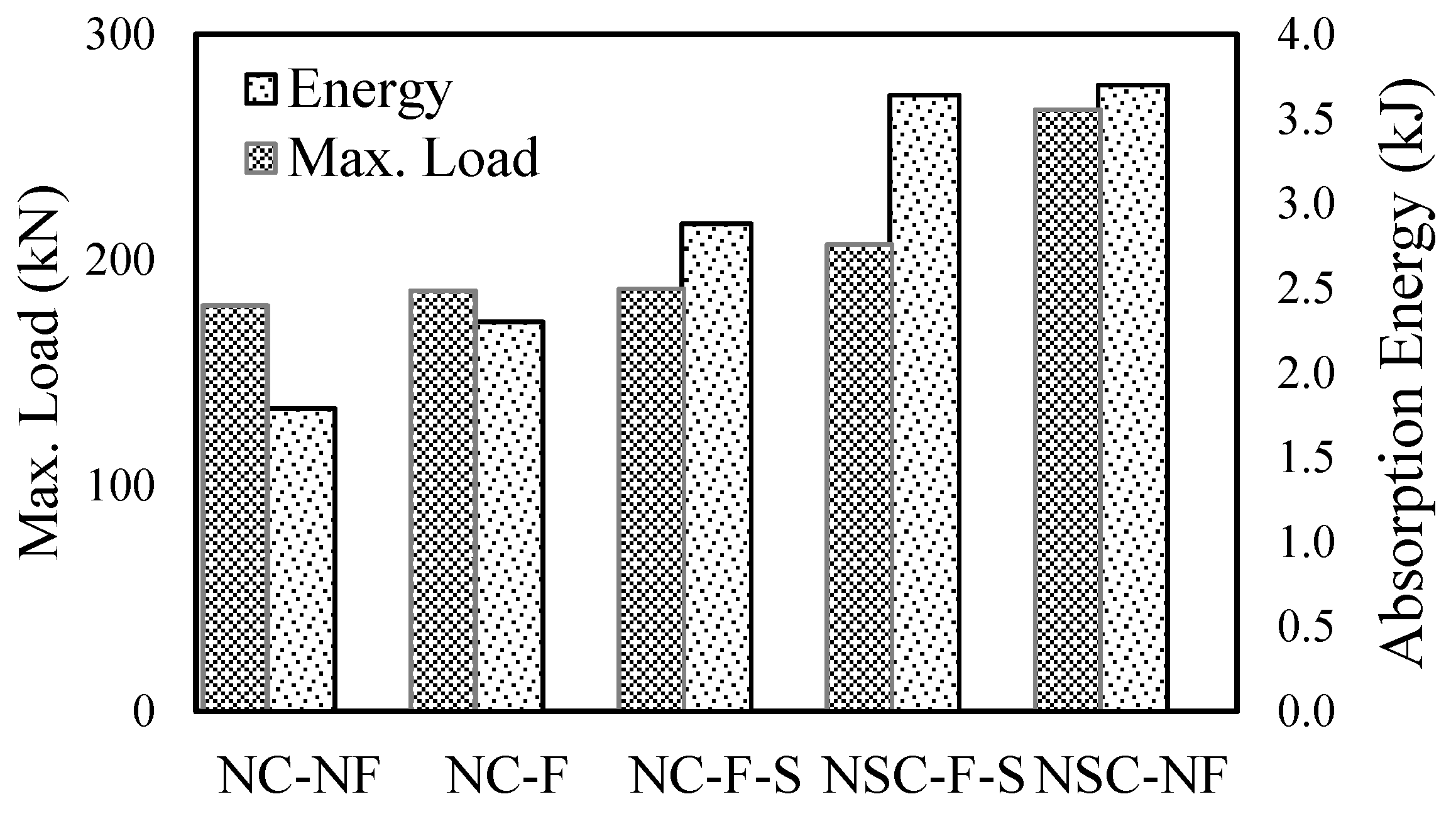
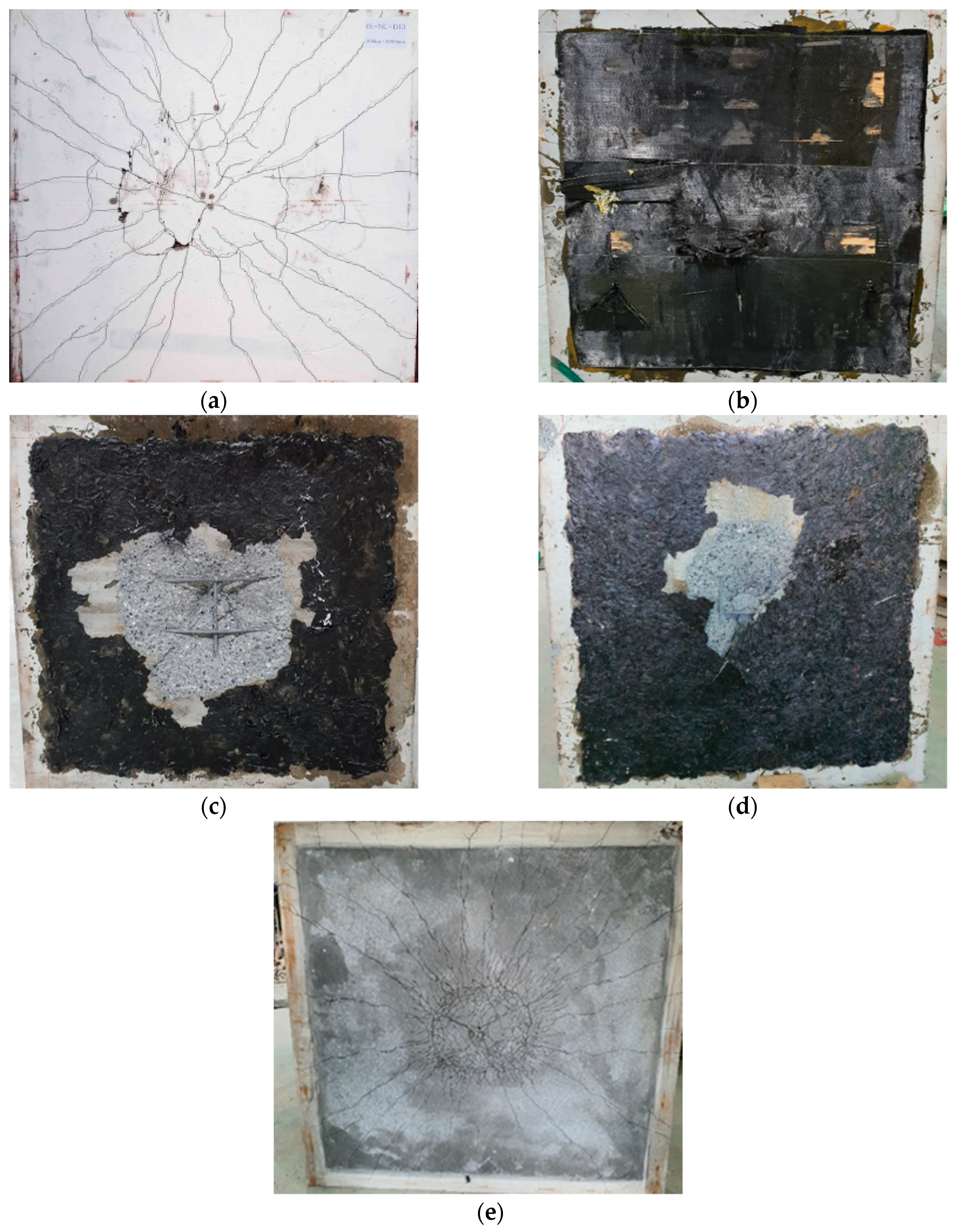
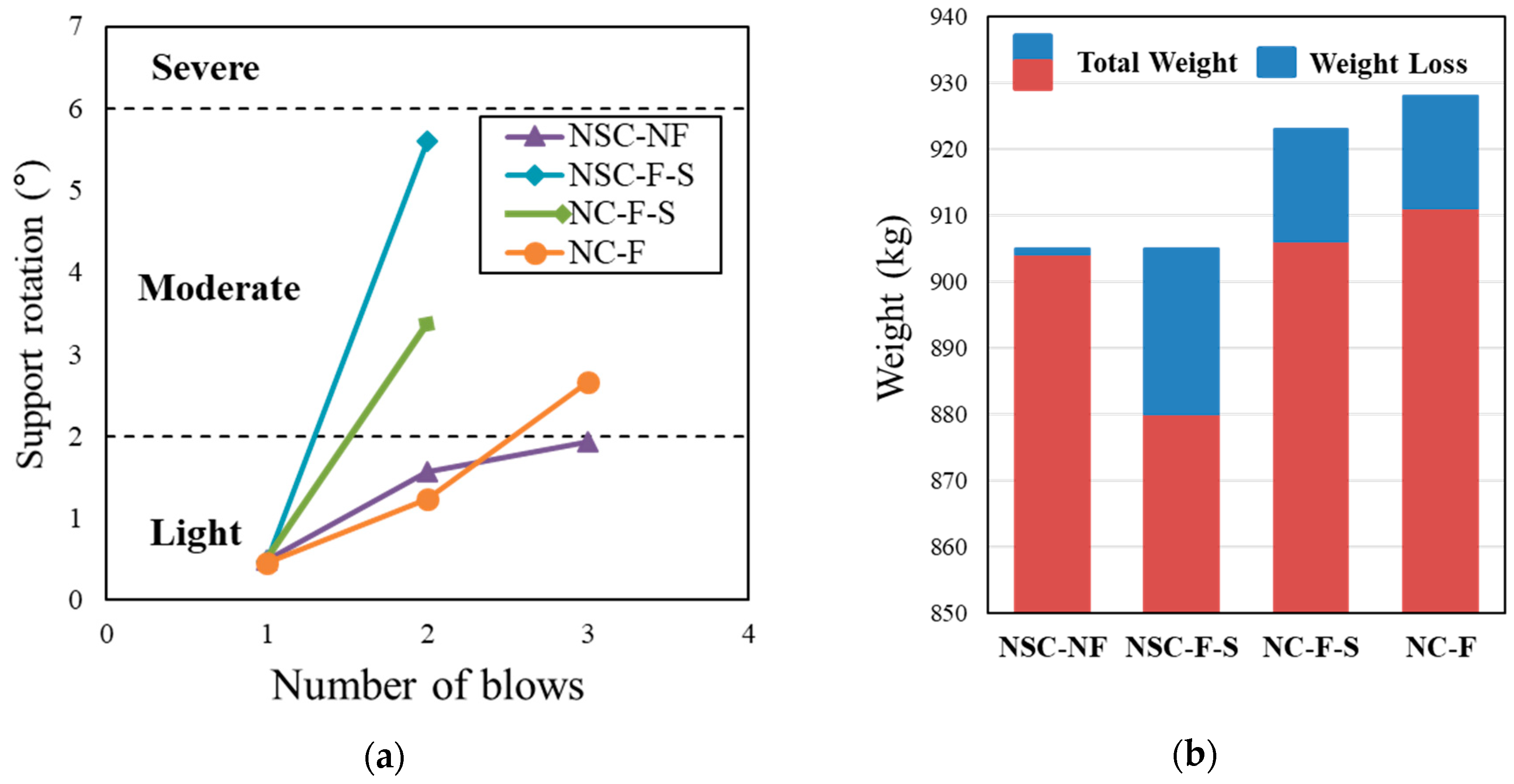
| Researchers | Strengthening Materials | Evaluation Method | ||
|---|---|---|---|---|
| 1. | Foret et al. 2008 | [5] | CFRP strip (two types spacing) | Numerical analysis |
| 2. | Bhatti et al. 2011 | [6] | FRP sheet (AFRP and CFRP sheet) | Test |
| 3. | Yoo et al. 2014 | [7] | FRP sheet (AFRP and CFRP sheet) | Test and numerical analysis |
| 4. | Radnic et al. 2015 | [8] | FRP strips (two types strengthening method) | Test and numerical analysis |
| 5. | Wang et al. 2018 | [9] | Flax FRP (different strengthening method) | Test |
| 6. | Yilmaz et al. 2018 | [10] | CFRP strips (two types strengthening method) | Test and numerical analysis |
| 7. | Elnagar et al. 2019 | [11] | Strain-hardening cementitious composites | Test and numerical analysis |
| 8. | Yang et al. 2019 | [12] | FRP sheet (different strengthening method) | Numerical analysis |
| 9. | Soltani et al. 2020 | [13] | GFRP sheets (different strengthening method) | Test and numerical analysis |
| 10. | Mugunthan et al. 2020 | [14] | GFRP strips (different strengthening method) | Test |
| 11. | Mahmoud et al. 2020 | [15] | Strain-hardening cementitious composites | Test |
| Type | w/b (%) | Unit Weight | |||
|---|---|---|---|---|---|
| Water | Cement | Fine Aggregate | Coarse Aggregate | ||
| NC | 33 | 0.33 | 1.00 | 1.43 | 1.70 |
| Type | w/b (%) | Unit Weight | Fiber | SP | |||||
|---|---|---|---|---|---|---|---|---|---|
| Water | Cement | Silica Fume | Silica Filer | Silica Sand | SF | PE | |||
| (%) | |||||||||
| NSHSDC | 17.2 | 0.215 | 1.00 | 0.25 | 0.30 | 1.10 | 1.0 | 0.5 | 3.0% |
| Specimens | Compressive Strength (MPa) | Flexural Strength (MPa) | Elastic Modulus (GPa) |
|---|---|---|---|
| NC | 40.7 | 4.24 | 27.42 |
| NSHSDC | 123.9 | 18.52 | 41.26 |
| Designation | Type of Strengthening Methods | Strengthening Thickness (mm) | |||
|---|---|---|---|---|---|
| NSC | Sprayed FRP | FRP Sheet | Top | Bottom | |
| NC-NF | - | - | - | - | - |
| NC-F | - | - | ○ | 0.34 | 0.34 |
| NC-F-S | - | ○ | - | 6 | 6 |
| NSC-F-S | ○ | ○ | - | 20 | 6 |
| NSC-NF | ○ | - | - | 20 | 20 |
| Series | Carbon Fiber | Resin | ||
|---|---|---|---|---|
| Sheet | Roving | Epoxy | Vinyl Ester | |
| Tensile strength (MPa) | 4900 | 4200 | 90 | 88 |
| Elastic modulus (GPa) | 230 | 240 | 30 | 7.3 |
| Ultimate strain (%) | 2.1 | 1.8 | 8.0 | 4.5 |
| Thickness (mm) | 0.167 | 3 | - | - |
| Test Members | Blow No. | Impact Properties | Max. Midspan Displacement | Residual. Midspan Displacement | Max. Reaction Force | ||
|---|---|---|---|---|---|---|---|
| H (mm) | Ei (kJ) | Fi (kN) | Dmax (mm) | Dres (mm) | Fr (kN) | ||
| NC-NF | 1 | 2000 | 5.89 | 410.10 | 23.41 | 7.75 | 179.75 |
| NC-F | 1 | 2000 | 5.89 | 611.97 | 17.31 | 5.92 | 186.36 |
| 2 | 320.96 | 23.80 | 10.15 | 225.52 | |||
| 3 | 282.16 | 19.33 | 19.29 | 176.20 | |||
| NC-F-S | 1 | 2000 | 5.89 | 637.58 | 17.91 | 6.57 | 187.16 |
| 2 | 369.29 | 51.96 | 37.60 | 212.64 | |||
| NSC-F-S | 1 | 2000 | 5.89 | 587.50 | 18.89 | 6.24 | 206.84 |
| 2 | 298.40 | 67.29 | 67.24 | 217.14 | |||
| NSC-NF | 1 | 2000 | 5.89 | 636.88 | 18.77 | 6.39 | 266.63 |
| 2 | 450.13 | 27.65 | 14.07 | 216.97 | |||
| 3 | 281.52 | 20.12 | 4.92 | 170.35 | |||
| Test Members | Blow No. | Mid-Span Displacement | ||
|---|---|---|---|---|
| Max. Displacement (mm) | Residual Displacement (mm) | Ratio of ∆max/∆res | ||
| NC-NF | 1 | 23.47 | 7.75 | 3.021 |
| NC-F | 1 | 17.31 | 5.92 | 2.924 |
| 2 | 23.80 | 10.15 | 2.345 | |
| 3 | 19.33 | 19.29 | 1.002 | |
| NC-F-S | 1 | 17.91 | 6.57 | 2.726 |
| 2 | 51.96 | 37.6 | 1.382 | |
| NSC-F-S | 1 | 18.89 | 6.24 | 3.027 |
| 2 | 67.29 | 67.24 | 1.001 | |
| NSC-NF | 1 | 18.77 | 6.39 | 2.937 |
| 2 | 27.65 | 14.07 | 1.965 | |
| 3 | 20.12 | 4.92 | 4.089 | |
| Damage Level | Light | Moderate | Severe |
|---|---|---|---|
| Support rotation criteria | 0° ≤ θ ≤ 2° | 2° < θ ≤ 6° | 6° < θ ≤ 8° |
| No. | Researcher | Test Specimens | Impact Energy (kJ) | Reaction Force (kN) | Max. Deflection (mm) | Dissipated Energy (kJ) | |
|---|---|---|---|---|---|---|---|
| 1. | This study | NC-NF | 5.89 | 179.75 | 23.41 | 1.79 | |
| 2. | This study | NC-F | 5.89 | 186.36 | 17.31 | 2.3 | |
| 3. | This study | NC-F-S | 5.89 | 187.16 | 17.91 | 2.88 | |
| 4. | This study | NSC-NF | 5.89 | 266.63 | 18.77 | 3.7 | |
| 5 | This study | NSC-F-S | 5.89 | 206.84 | 18.99 | 3.64 | |
| 6. | Hrynyk et al. 2014 | [4] | Steel fiber (1%) | 4.8 | 591 | 14 | 3.5 |
| 7. | Hrynyk et al. 2014 | [4] | Steel fiber (2%) | 4.8 | 621 | 13.5 | 4.2 |
| 8. | Hrynyk et al. 2014 | [4] | Steel fiber (3%) | 4.8 | 531 | 12.4 | 3.3 |
| 9. | Bhatti et al. 2011 | [6] | CFRP strips | 5.4 | 240 | 32 | 3.84 |
| 10. | Amira et al. 2019 | [11] | Cementitious composites | 5.93 | 61 | 2.65 | 2.51 |
| 11. | Mugunthan et al. 2020. | [14] | GFRP strips | 4.86 | - | - | - |
| 12. | Jang 2015 | [49] | Steel fiber (1%) | 5.89 | 408.6 | 20.08 | 4.85 |
| 13. | Kim 2017 | [50] | UHPC | 6.13 | 272.72 | 17 | 4.64 |
Publisher’s Note: MDPI stays neutral with regard to jurisdictional claims in published maps and institutional affiliations. |
© 2020 by the authors. Licensee MDPI, Basel, Switzerland. This article is an open access article distributed under the terms and conditions of the Creative Commons Attribution (CC BY) license (http://creativecommons.org/licenses/by/4.0/).
Share and Cite
Yoo, S.-J.; Yuan, T.-F.; Hong, S.-H.; Yoon, Y.-S. Effect of Strengthening Methods on Two-Way Slab under Low-Velocity Impact Loading. Materials 2020, 13, 5603. https://doi.org/10.3390/ma13245603
Yoo S-J, Yuan T-F, Hong S-H, Yoon Y-S. Effect of Strengthening Methods on Two-Way Slab under Low-Velocity Impact Loading. Materials. 2020; 13(24):5603. https://doi.org/10.3390/ma13245603
Chicago/Turabian StyleYoo, Sun-Jae, Tian-Feng Yuan, Se-Hee Hong, and Young-Soo Yoon. 2020. "Effect of Strengthening Methods on Two-Way Slab under Low-Velocity Impact Loading" Materials 13, no. 24: 5603. https://doi.org/10.3390/ma13245603
APA StyleYoo, S.-J., Yuan, T.-F., Hong, S.-H., & Yoon, Y.-S. (2020). Effect of Strengthening Methods on Two-Way Slab under Low-Velocity Impact Loading. Materials, 13(24), 5603. https://doi.org/10.3390/ma13245603







